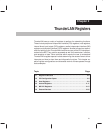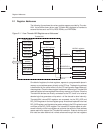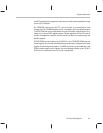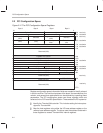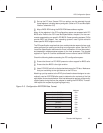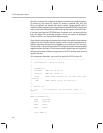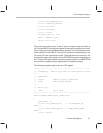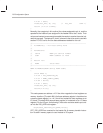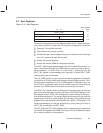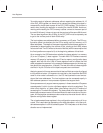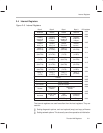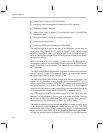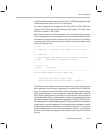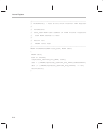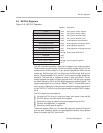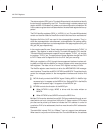
Host Registers
2-9
ThunderLAN Registers
2.3 Host Registers
Figure 2–4. Host Registers
offset
Base address
+12
+8
+4
+0
DIO_DATA
DIO_ADRHOST_INT
CH_PARM
HOST_CMD
0151631
ThunderLAN implements the host registers shown above. These are the pri-
mary control points for ThunderLAN. Through the host registers, a driver can:
Reset the ThunderLAN controller
Start transmit and receive channels
Handle interrupts: Acknowledge interrupts, turn certain kinds of interrupts
on or off, or pace interrupts with the host
Access the internal registers
Access the internal SRAM for diagnostic purposes
The
HOST_CMD
register gives commands to the ThunderLAN controller. It is
used in conjunction with the CH_PARM register to start the transmit and re-
ceive processes (Tx GO/Rx GO). It is also used in conjunction with the
HOST_INT register to acknowledge (ack) interrupts. Through HOST_CMD,
interrupt pacing can be selected.
The
CH_PARM register is used to give the physical addresses of a transmit
or receive list to ThunderLAN’s direct memory access (DMA) controller. Thun-
derLAN uses the address in the CH_PARM register to DMA data into or out
of its FIFOs. In an adapter check, an error condition where ThunderLAN must
be reset, CH_PARM contains information on the nature of the error.
The
HOST_INT register contains information on the type of interrupt that was
given to the host processor. It is also used with the
CH_PARM register to indi-
cate adapter checks. HOST_INT is designed to make interrupt handling rou-
tines simple and powerful. The last two significant bits are set to 0 so that this
register may be used as a table offset in a jump table. The bit definitions are
mapped to the most significant word (MSW) of the HOST_CMD
register. This
allows acknowledging of interrupt operations by simply taking the value in
HOST_INT and writing it to HOST_CMD.
The DIO_ADR and DIO_DATA registers work in tandem to allow accesses to
the internal DIO registers and SRAM. The value in DIO_ADR selects the regis-
ter or memory locations to be accessed.



